Escape From the City....
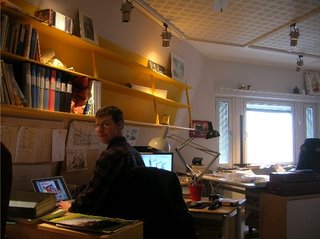 A few weeks ago I realized that I have been in this city--usually in my office pecking away at a computer keyboard-- for more than three solid months (yes, to be completely fair I did leave Stockholm for a week to visit Berlin, but that too was a city , a bigger one in fact).
A few weeks ago I realized that I have been in this city--usually in my office pecking away at a computer keyboard-- for more than three solid months (yes, to be completely fair I did leave Stockholm for a week to visit Berlin, but that too was a city , a bigger one in fact).On the one hand, this fact is a great complement to Stockholm which is easily the finest city I have ever visited. However, on the other hand, for me--a guy who prefers the rural outdoors and quiet, natural environs--three months in a city is on par with being held in a medium security prison. I had to get out.
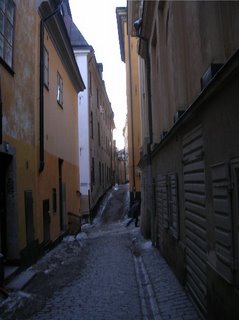 Don't get me wrong; I love Stockholm, but there is such a thing as 'too much of a good thing'. After three months the city's forest of stone, steel, and concrete was hemming me in from all sides. This photo of a street on Gamla Stan (Old Town) is an extreme example, but it captures my point.
Don't get me wrong; I love Stockholm, but there is such a thing as 'too much of a good thing'. After three months the city's forest of stone, steel, and concrete was hemming me in from all sides. This photo of a street on Gamla Stan (Old Town) is an extreme example, but it captures my point.
Fortunately I met with a spectacular opportunity to escape from the city. My good friends Ole Magnus (the rope-maker) and his wife Annetta both of whom I met during my days living aboard the icebreaker Sankt Erik, invited me to come to their home near Århus, Denmark for Easter. I think I accepted before they even finished asking me.
The opportunity to escape the city, travel with good company, and to see another part of Scandinavia--with excellent guides for seeing the maritime heritage part of Scandinavia--struck me like a work of divine intervention.
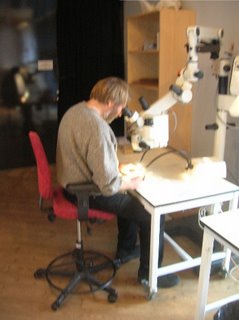
So, early on a Friday morning we met at Vasa Museet, Ole took a last look at a Vasa rope sample through the microscope (it was a singularly unique piece full of interesting mysteries), and then we set off in a little Citröen sedan on a journey clear across Sweden to the Danish Straits and beyond.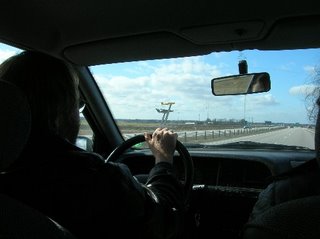
My,...I tell you it was one heck of a great feeling to emerge from the maze of city streets, billboards, and blocky apartment buildings and burst out onto the open landscape! It was such a relief to break free of the city and see furrrowed fields, cute little red farm houses, and small woodlots.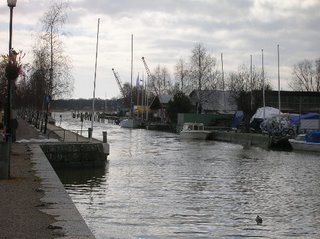
After an hour or two of driving, we stopped at the little port town of Trosa, south of Stockholm, to stretch our legs, get a bite of bread and cheese, and have a 'spot of tea'. Huddled against the early spring wind on a bench overlooking the canal, we watched a few bold yachtsmen in the boatyard painting hulls and peeling off the winter tarps. Meanwhile we were being accosted by a pair of very hungry and demanding mallards....
Trosa was an interesting little village. Once a busy fishing port, it now hosts flotillas of fiberglass yachts in the summer. Its harbor leads out to the Baltic through a long fjord opening up to the Stockholm archipelago.
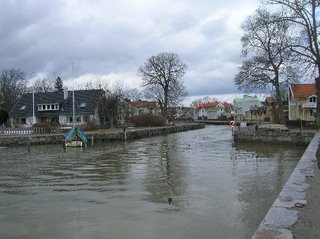
The village itself is composed of quiant, little houses (most are older than the US) arranged along these winding canals on which the fishermen used to make their daily commute.
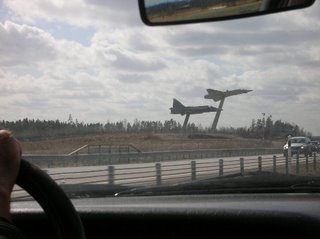 Back on the road again and relishing every moment of its freedom, I watched the sights blow by as we approached the big city of Linköping, home of SAAB. When most of us think of SAAB, we generally think of their cars, but along the highway near Linköping, it is SAAB's aircraft division that takes all the glory, displaying its aircraft (primarily the fighter jets) on pedestals for passing motorists to marvel.
Back on the road again and relishing every moment of its freedom, I watched the sights blow by as we approached the big city of Linköping, home of SAAB. When most of us think of SAAB, we generally think of their cars, but along the highway near Linköping, it is SAAB's aircraft division that takes all the glory, displaying its aircraft (primarily the fighter jets) on pedestals for passing motorists to marvel.Sweden may not have engaged in armed conflict in two centuries, but don't think for a moment that Sweden isn't capable and ready. During the following two days in western Sweden I saw plenty of these jets doing low-level, high-speed maneuvers over the countryside.
A little further along the road we found a few lasting legacies of Sweden's military might as well...

After falling asleep in the back seat for a while, I woke up to find us skirting the edge of the enormous Lake Vättern in central Sweden and approaching the little port town of Grenaa. In the days when virtually all inland transport went by water--sailing up and down these huge lakes, canals, and rivers--the little town of Grenaa half way up the lake was a rediculously wealthy boom-town. Hosting weary merchants and charging tolls to lake traders, Grenaa became a bustling port. To safeguard its commercial authority, this castle fortress was constructed centuries ago on the high bluff behind the city.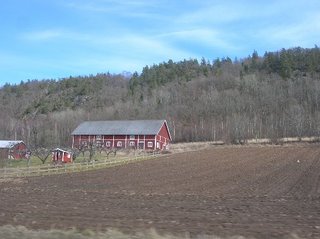
Below the castle and its rocky perch lay the farms, inns, and shops of the old town, all built on the narrow sweeping shelf leading down to the lake.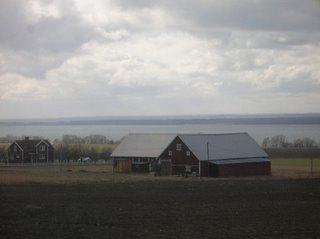
The classic Swedish farms with their red barns and little farm houses were a beauty beyond measure to my city-weary eyes. Likewise, to finally gaze out over open water again was a treat to be savored.
Feeling 'a might peckish,' we decided to stop in Grenaa for a snack. Ole and Annetta knew of a cracker bakery that made excellent knäckebröd and a nice little cafe that was a reliable source of fine desserts.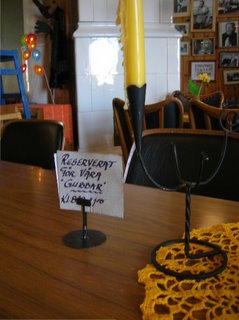 Inside the little 1950's Rock'n'Roll-themed cafe I found a wonderful caramel brownie, a good cup of hot tea, and this amusing little sign sitting on a table. It reads "Reserverat för våra 'Gubbar' kl. 8:30-11:30," that is, "Reserved for our 'Old men', 8:30-11:30." This was clearly the Swedish equivelent of a stammtisch where the 'pensioners' gathered to discuss the issues/gossip of the day. On the back of the sign I found an underexposed photo taped on with none-too-much care showing five old codgers with stained coffee mugs hunched over the table; the venerated 'Gubbar'.
Inside the little 1950's Rock'n'Roll-themed cafe I found a wonderful caramel brownie, a good cup of hot tea, and this amusing little sign sitting on a table. It reads "Reserverat för våra 'Gubbar' kl. 8:30-11:30," that is, "Reserved for our 'Old men', 8:30-11:30." This was clearly the Swedish equivelent of a stammtisch where the 'pensioners' gathered to discuss the issues/gossip of the day. On the back of the sign I found an underexposed photo taped on with none-too-much care showing five old codgers with stained coffee mugs hunched over the table; the venerated 'Gubbar'.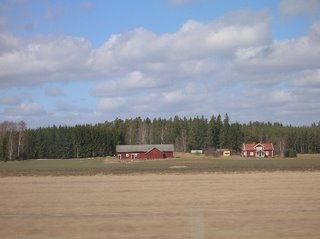 Then onward, south to Jonköping and west toward Göteborg and Kungälv. Mile after mile (kilometer after kilometer, actually) of little farms and patches of forrest streamed by the window. I found myself rather attracted to the Swedish landscape. It does get a little repetative after the fourth hour on the road, but somehow it holds you rinterest. Maybe it was the greenery adn the open expanses of space that I have been without in the city, or maybe it was that central Sweden reminds me very much of Wisconsin; the fields, the woodlots, the Scandinavian architecture...
Then onward, south to Jonköping and west toward Göteborg and Kungälv. Mile after mile (kilometer after kilometer, actually) of little farms and patches of forrest streamed by the window. I found myself rather attracted to the Swedish landscape. It does get a little repetative after the fourth hour on the road, but somehow it holds you rinterest. Maybe it was the greenery adn the open expanses of space that I have been without in the city, or maybe it was that central Sweden reminds me very much of Wisconsin; the fields, the woodlots, the Scandinavian architecture...

Some of the bigger villages we passed had once rallied funds to build some rather sizable churches. Their steeples poked up from the horizon, standing above the trees and guiding you from village to village.
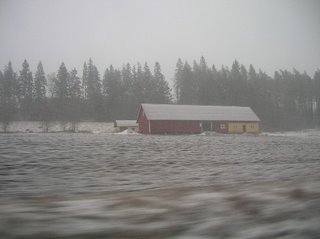
Then, as we drove further west, the clouds darkened and we traveled back into winter. First it was a few flakes, the the oncoming traffic was caked with fresh snow, and then it was a near white-out.
After a winter here in Sweden, snow is nothing worthy of note, but what we didn't know was that this was the last snowfall we would see this year. Spring was waiting for us just across the channel...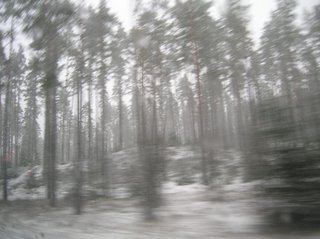
Our windshield-wipers urgently flipping back and forth, we drove on into the big forests of Western Sweden, weaving along under a canopy of towering pines ('towering' by a non-BC-WA-OR-CA standard). Periodically the pines broke to shelter a patch of birch. Together, pine and birch are the foundation of Sweden's massive timber industry.
Periodically the pines broke to shelter a patch of birch. Together, pine and birch are the foundation of Sweden's massive timber industry.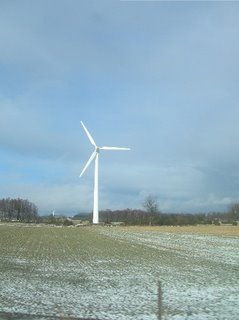 Emerging from under the storm front, we drove out into the sun again and cruised over rolling hills and valleys. By then it was clear that we were getting close to the coast; Danish-built wind turbines began to dot the landscape and the wind blew with a sharper bite.
Emerging from under the storm front, we drove out into the sun again and cruised over rolling hills and valleys. By then it was clear that we were getting close to the coast; Danish-built wind turbines began to dot the landscape and the wind blew with a sharper bite.
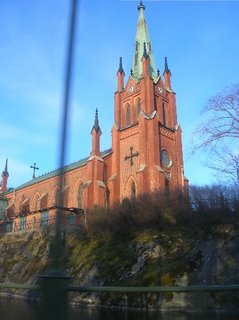
Like Grenaa, Trollhättan was once a very wealthy trade route city, a fact visible in its huge cathedral built on a rocky islet. The town stands over the famous Trollhätten locks which move vessels over the last great barrier in the Göta Canal on their way to its western terminus in Götaborg. For eastbound vessels leaving Göteborg, the series of locks (there were 9 in a row when it was first opened in 1800) marks the beginnning of a long journey into the Swedish heartland, opened by the Göta Canal, reaching all the way across the country to Stockholm.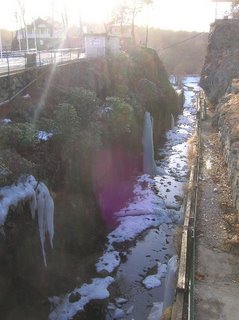 The original locks opened in 1800 were dug out of the bedrock by hand. For decades, burly Swedes swung their picks into the hard stone to build these trenches. Then, gates and valves were installed in all 9 locks, the oldest of which still remain today. Here, one of the original locks from 1800 with dramatic icicles as big as a car hanging from the walls.
The original locks opened in 1800 were dug out of the bedrock by hand. For decades, burly Swedes swung their picks into the hard stone to build these trenches. Then, gates and valves were installed in all 9 locks, the oldest of which still remain today. Here, one of the original locks from 1800 with dramatic icicles as big as a car hanging from the walls.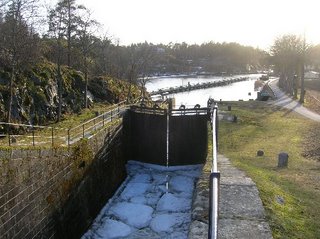 Then, with more advanced technology (and plenty of explosives), new locks were built to carry the ever-larger vessels being used in the inland trade. This parallel series of locks was opened in 1844.
Then, with more advanced technology (and plenty of explosives), new locks were built to carry the ever-larger vessels being used in the inland trade. This parallel series of locks was opened in 1844.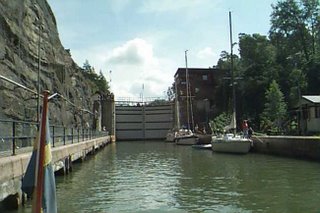 Then, in 1916, a third set of parallel locks was completed that can handle the biggest vessels. Predominantly these locks are filled by summer yachtsmen traveling between the vacation grounds of the huge inland lakes and coastal archipelagos.
Then, in 1916, a third set of parallel locks was completed that can handle the biggest vessels. Predominantly these locks are filled by summer yachtsmen traveling between the vacation grounds of the huge inland lakes and coastal archipelagos.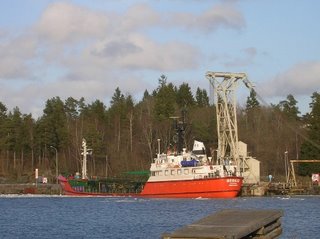 But the Trollhätten Locks and the Göta Canal still have a thriving commerical purpose and as many as twenty cargo ships a day may pass through Trollhätten. When we visited, this tanker had recently come through and was discharging at a nearby oil depot. You can see this is a pretty large vessel--maybe 220ft--and ships like this travel hundreds of kilometers into Sweden's interior. For many cargoes, shipping is still more efficient than trucking despite Sweden's advanced freeway system.
But the Trollhätten Locks and the Göta Canal still have a thriving commerical purpose and as many as twenty cargo ships a day may pass through Trollhätten. When we visited, this tanker had recently come through and was discharging at a nearby oil depot. You can see this is a pretty large vessel--maybe 220ft--and ships like this travel hundreds of kilometers into Sweden's interior. For many cargoes, shipping is still more efficient than trucking despite Sweden's advanced freeway system.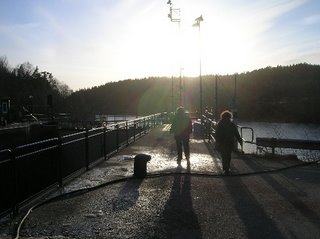 However, amidst our marveling at the great waterworks of the locks, the sun was setting and the day's journey was not yet over. So Ole, Annetta, and I climbed back in the car for th efinal trip to our destination in Älvängen.
However, amidst our marveling at the great waterworks of the locks, the sun was setting and the day's journey was not yet over. So Ole, Annetta, and I climbed back in the car for th efinal trip to our destination in Älvängen.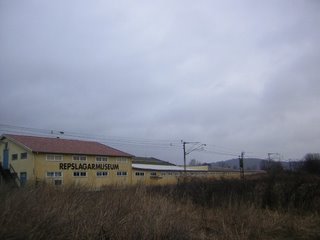
Arriving in the tiny riverside village of Älvängen, I easily spotted our workplace; you just can't hide a 300meter ropewalk--especially in a ten-house town. Älvängen is home to one of Sweden's last remaining ropewalks--now a museum, Repslagermuseum.
But we weren't there jsut to visit a museum and entertain Ole's passion for rope-making. This was a business trip...
 We were greeted at the door by the crew of the Viking Ship replica Sif Ege, built and based in Fredrikssund, Denmark. They were all good friends of Ole and Annetta; one of the wonderful results of the close-knit community among maritime enthusiasts and scholars--and the close proximty of all their homes in Denmark.
We were greeted at the door by the crew of the Viking Ship replica Sif Ege, built and based in Fredrikssund, Denmark. They were all good friends of Ole and Annetta; one of the wonderful results of the close-knit community among maritime enthusiasts and scholars--and the close proximty of all their homes in Denmark.Ole had been invited to meet them here in Älvängen, Sweden to help them make an entirely new set of natural fiber rigging for Sif Ege.

After a lengthy round of greetings, we all went out into the rope-walk for an introductory tour. It is an impressive structure; simple construction but so insanely long that in the evening hour even with the lights on, the far end of the rope-walk was indiscernable in the distance.
Then, after raiding and conquering a pizzeria in true Viking fashion (actually, we just took all the tables), our first day came to an end. We stayed in the museum for the night, sleeping in the hemp exhibit (restrain your laughter), resting up for the next day's hard work.

2 Comments:
hollister outlet
ralph lauren outlet
polo ralph kids
louis vuitton
air jordan 8
montblanc
vans sneakers
michael kors outlet
jordan retro 13
michael kors
asics shoes
ray ban sunglasses
cheap toms
louis vuitton handbags
ralph lauren polo
the north face outlet
michael kors handbags
kobe 11
cheap jordan shoes
coach factory outlet
insanity workout
michael kors outlet
michael kors handbags
louis vuitton outlet online
coach outlet store online clearances
marc jacobs handbags
cheap jerseys
michael kors canada
jordan 11
coach outlet canada
chenyingying2016713
The opportunity to escape the city, travel with good company, and to see another part of Scandinavia--with excellent guides for seeing the maritime heritage part of Scandinavia--struck me like a work of divine intervention.
pure egyptian cotton bedding
pure cotton sheets 1000 thread count
Post a Comment
<< Home